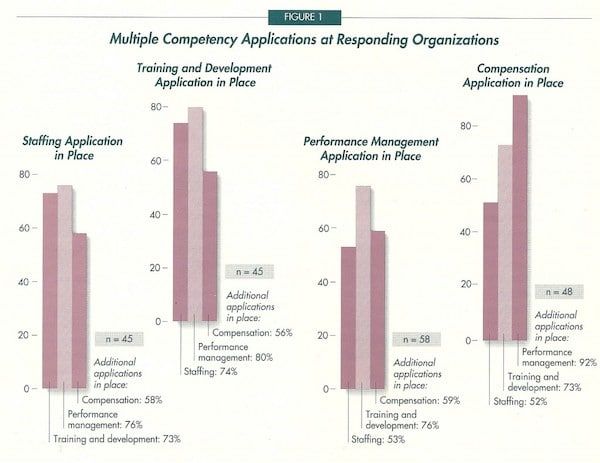Background
In 1996, the American Compensation Association (now WorldAtWork) sponsored a research study titled “Raising the Bar – Using Competencies to Enhance Employee Performance”. It was authored by Michael Thompson of the Hay Group, Dr. Edward Gubman of Hewitt Associates, Sandra O’Neal of Towers Perrin (now Towers Watson), and Darrell Cira of William M. Mercer Inc. (now Mercer) The results were published in a 76-page booklet, which has been long out of print. I recently discovered and re-read a copy I had filed away. What is interesting is that most of the findings are still relevant and insightful today..
To get a sense of how business and human resources strategy might impact decisions about competency applications, the research team had asked participating companies to state their primary business strategy objectives, how their HR strategies support these objectives and the intended purpose of implementing competency-based applications.
An Overview of Findings
This comprehensive research project demonstrated the connection competencies make with business strategy, the techniques organizations use to build competency models, and the similarities and differences among competency-based human resources applications at responding organizations. Competency-based human resources applications were relatively new; many respondents said it was too early to judge whether competencies had fulfilled their potential as a means to improve employee performance and, ultimately, enhance business results. However, respondents’ attitudes toward competencies were largely positive, and a large majority of respondents wanted to expand the role of competencies within their organizations.
Keeping in mind the nature of the sample, which limited the ability to draw widespread conclusions about the workplace in general, it was still possible to identify important conclusions based on the data. Following are the key findings of this research effort:
- Competencies are used to “raise the bar” on employee performance. Respondents said”raising the bar”
 is a key objective of competencies, as opposed to using competencies to establish a baseline for performance. Also, respondents tailored their HR applications to focus on individual performance. Competencies are defined thoroughly (often using high performers and functional experts as a primary source of input), and they often are supported with scaled levels to illustrate increasing levels of proficiency. This provides individuals with detailed road maps for increasing their capabilities incrementally.
is a key objective of competencies, as opposed to using competencies to establish a baseline for performance. Also, respondents tailored their HR applications to focus on individual performance. Competencies are defined thoroughly (often using high performers and functional experts as a primary source of input), and they often are supported with scaled levels to illustrate increasing levels of proficiency. This provides individuals with detailed road maps for increasing their capabilities incrementally.
For staffing applications, competencies are used to hire, place and promote people with the right capabilities to help the organization gain competitive advantage. For training and development, competencies are used to identify gaps in each participating employee’s capabilities so these gaps can be remedied. For performance management, competencies and results are assessed side by side, reminding employees that how they do things is as important as what they do. For compensation, both competencies and results impact base pay decisions to reward performance and competency development. - Competencies are used to focus on an organization’s culture and values. Many respondents indicate they use competency-based applications to communicate values to the work force and to build the proper culture for success. While these issues may appear somewhat removed from the bottom line, it appears that many organizations recognize the importance of culture in achieving competitive advantage.
- Business strategies inform competencies. Competency information comes from multiple sources, and strategy plays a key role in development. The most frequent source of information is senior management and strategic plans. The next most common sources of information are high performers and functional experts. These sources of information often are used in combination.
- Competencies focus on how performance results are achieved. Competencies are behavioral models that are built upon skills, knowledge and personal attributes. Furthermore, all attributes of competencies should be observable and measurable, and they must contribute to enhanced employee performance and, in turn, organizational success.
- Today’s competency applications are evolutionary, not revolutionary. This finding is supported by several observations. First, it appears that competency based approaches are treated as add-ons and they are not leading to radical adjustments in HR processes. Second, with regard to specific HR applications, managers continue to make the lion’s share of performance management and compensation decisions. Furthermore, with the exception of the use of behaviorally anchored rating scales, base salary adjustments under competency based systems are largely made in a traditional fashion. Finally, for staffing purposes, competencies are rarely used when checking references or as the sole basis for rejecting candidates.
- Competencies provide a framework for integrating HR applications. Integrating HR applications is a desired outcome for many organizations. Many respondents had more than one competency-based HR application. (See Figure 1.) Those who have applications in place for more than a year desire to expand competencies into additional HR areas. Lessons learned in one area of competency-based HR should be applied to other competency applications
- Compensation is the least common and newest application. Compensation is the least cited application in this sample, performance management is the most cited application, and staffing and training and development are in between. Staffing applications tend to be oldest, followed by performance management, training and development, and compensation applications. (See Figure 2.) This may imply that staffing applications represent starting points for many organizations that are interested in competencies. Compensation is seen as an application that can be added once other applications are in place. One reason for why staffing applications are older may be historical; recall that McClelland’s early work with competencies was to examine them for selection purposes.
These findings should not be interpreted as a prescription for the order in which to install competencies. The researchers have observed many organizations that started competencies in different areas of HR and then gradually worked their way to other areas. In fact, many organizations also work on more than one application at once. The key is not the order in which areas are approached but how these applications ultimately are integrated and linked to business strategy.
- It is too early to tell how effective competencies are. The newness of many competency-based applications in this sample means that the ultimate success or failure of these applications -and their integration -remains to be seen. Among those respondents who felt comfortable passing judgment, reaction to the effectiveness of competencies was largely positive.”
Questions for discussion:
Which findings are still valid? What has changed since this study was published? What has not changed? What do you envision for the future? Challenges and opportunities?
 To learn more about our products and services, and how competencies and competency models can help your organization, call 800-870-9490, email edward.cripe@workitect.com
To learn more about our products and services, and how competencies and competency models can help your organization, call 800-870-9490, email edward.cripe@workitect.com
or use the contact form at Workitect.
©️2024, Workitect, Inc.




Leave A Comment